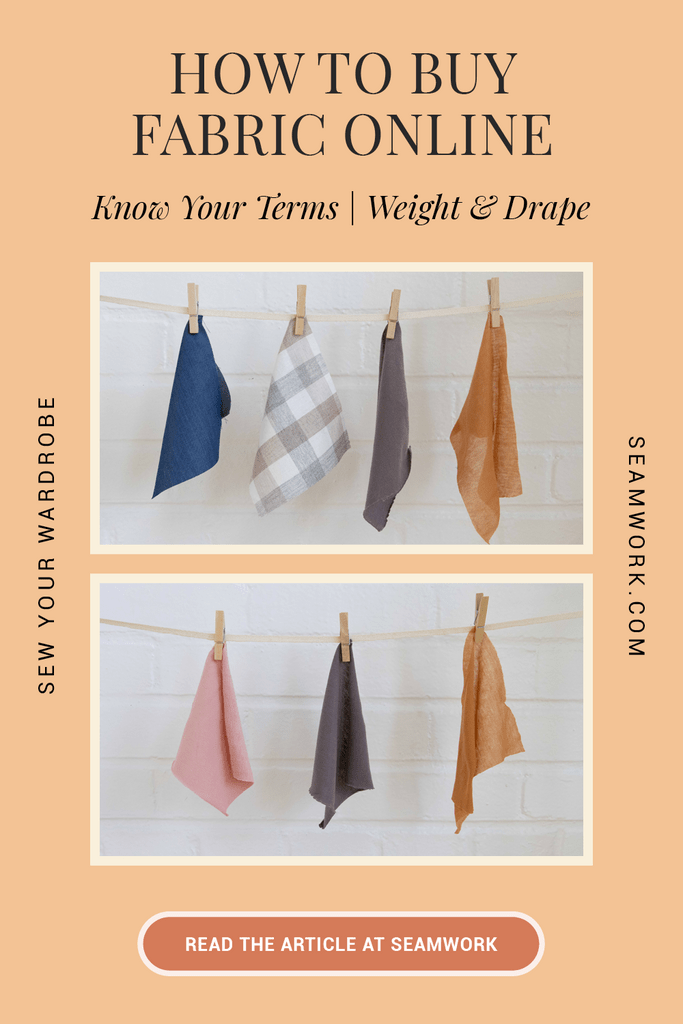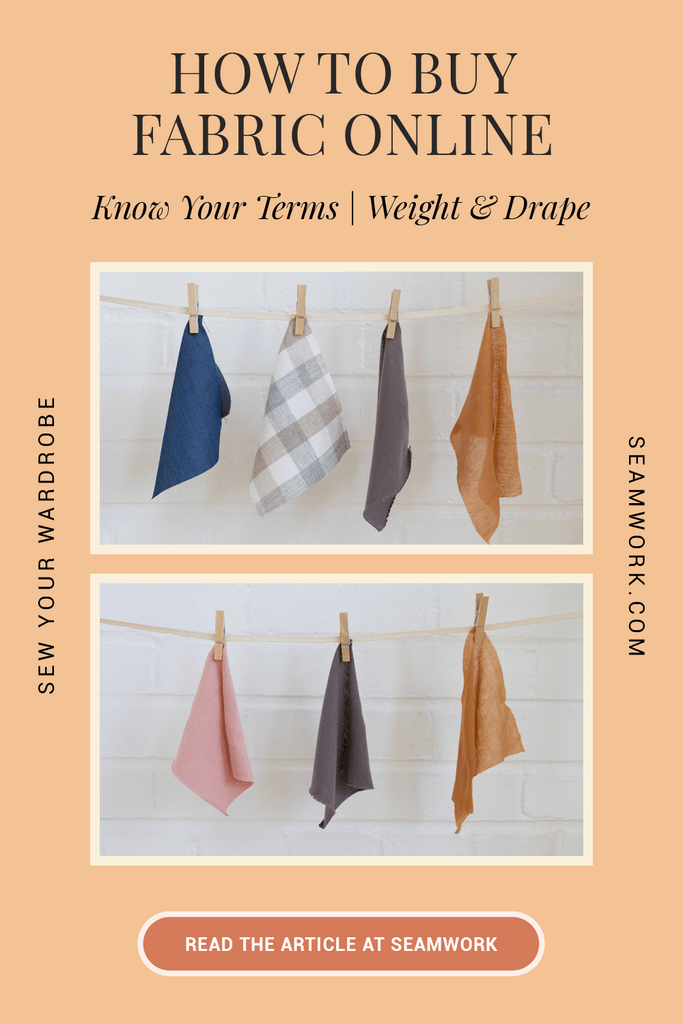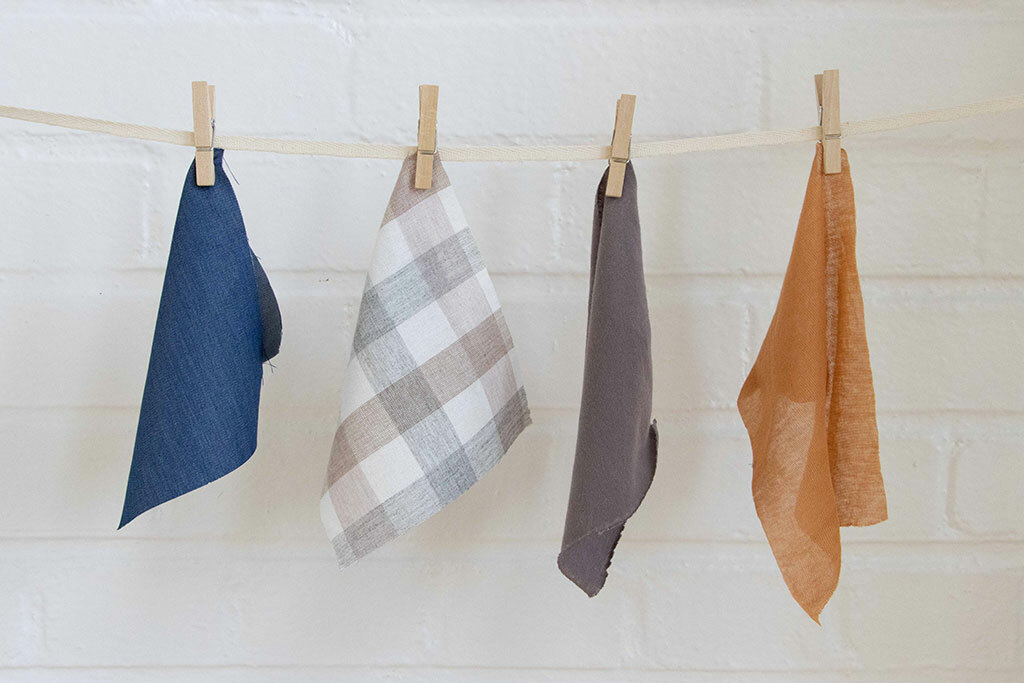
When you shop for fabric online, can you picture how the fabric will look on your body or feel when you sew with it? Or is it hard to imagine what you’ll get when your online fabric order arrives at your doorstep?
There are two ways to really know your fabric, and the first way is technical. You can research the qualities of individual fibers—like cotton, rayon, silk, polyester, or wool. This will give you an idea of how the fibers absorb dye, if they wick moisture, or if they keep you warm or cool. Then you can discover how those fibers are knit or woven together to make a particular fabric. For example, fibers might be combined with nylon or spandex to get stretchy, or they might be woven in a way that creates texture on the surface, like twill or corduroy. This is all knowledge you can get online, in books (see a recommended list below), or with experience, as you sew.
But the second way to really know your fabric is sensory. You see how the fabric drapes on your body, how hefty it feels when you pick it up, and how it moves when you walk. Unfortunately, when you shop for fabric online, you miss out on almost the entire sensory experience.
So if you can’t touch your fabric before buying it, a quick vocabulary lesson can help bring fabric descriptions to life. Getting familiar with the sensory qualities of fabric—specifically weight and drape—helps you know how it will behave when you unbox it, sew it, and wear it.
Know your terms: weight and drape
Online fabric stores have the challenging task of translating a fabric’s behavior into a written description. Your job when you shop is to learn how to interpret their fabric descriptions. As you read a fabric description, take note of the fiber content and then look at the adjectives that stores use to describe weight and drape. The more you do this, the more quickly you’ll learn to speak textiles.
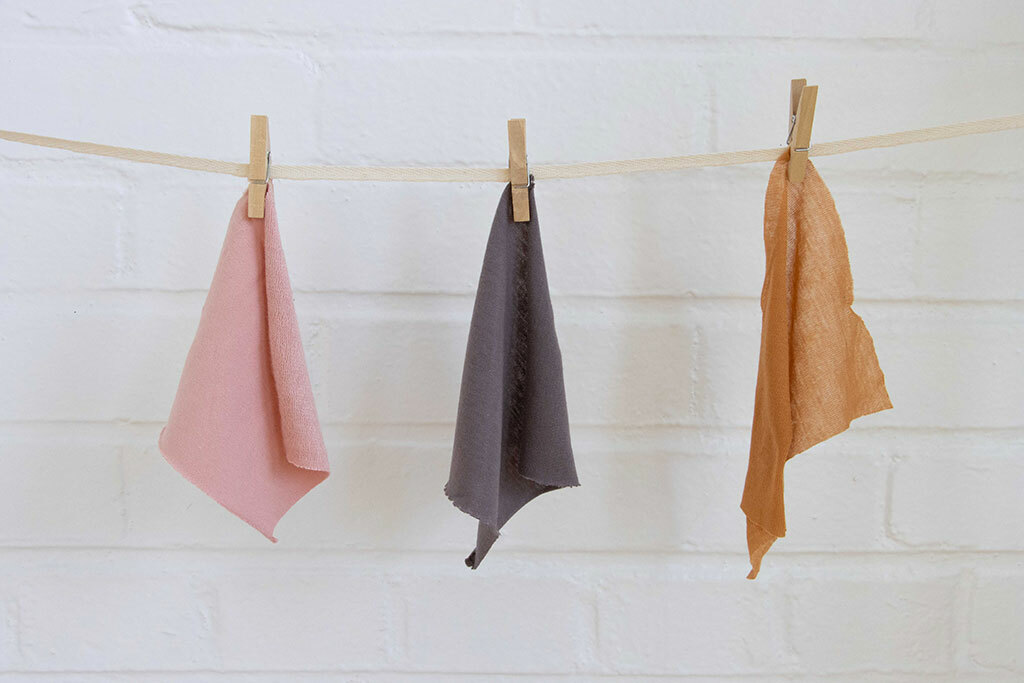
Briefly, the weight of the fabric is how light or heavy it is, and the drape of the fabric is how it hangs on your body. So let’s take a closer look at each of these terms.
Weight
What is it?
The weight of a fabric is how much it weighs—how light or heavy it is when you hold it. So while you will see fabrics described casually as lightweight, medium weight, or heavyweight, each fabric also has a specific, numerical weight.
Depending on where you are fabric shopping, you’ll find the imperial measurement is usually ounces per square yard (OYS), and the metric measurement is usually grams per square meter (GSM). If you need to translate between the two, here is a handy fabric weight calculator.
But what do these numbers mean when shopping for fabric for a specific sewing project? Here are some general examples of how you can think about weight for your sewing project:
- Lightweight fabrics might be thinner, more breathable, drapier, and less opaque than their heavyweight counterparts. These fabrics are up to about 7oz or 237 GSM.
- Similarly, heavyweight fabrics might be thicker, more durable, more opaque, and more structured than their lightweight counterparts. These fabrics are more than 11oz or 475 GSM.
- Medium-weight fabrics will be somewhere between the two, at about 7-11oz or 373-475 GSM.
It’s important to note that the GSM of fabric is only a reflection of the weight per square yard or meter. It doesn’t have additional information, like the density of the weave, other fiber contents, the qualities of the drape, or the fabric’s stretch. So while you might find the fabric’s specific weight listed, you will need to rely on the description to get more information.
Example: Denim
Denim is an excellent example for exploring weight because online fabric shops often provide very detailed information, and ready-to-wear jeans often list the specific weight of the denim. You’ll find lightweight, medium-weight, and heavyweight denim, between 5 ounces and 32 ounces.
Denim also requires you to consider how you want your garment to feel on your body. For example, heavyweight denim might survive more wear and tear than lightweight denim. However, it is also likely to feel more restrictive on your body until you break it in.
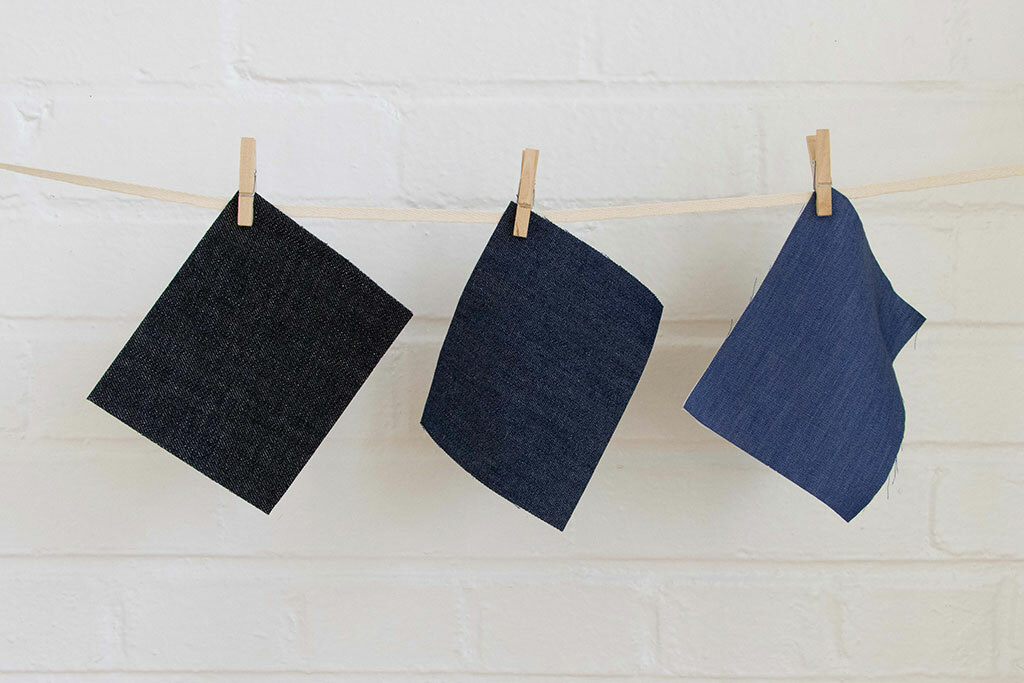
The denim swatch on the left is listed as heavyweight. It’s 438 GSM (12.9 oz) and described online as stiff, durable, and heavy, ideal for sturdy jeans, aprons, and overalls. Notice how this denim swatch maintains its shape even when hanging. The fabric is so heavy that it remains stiff and doesn’t drape.
The middle denim is listed as medium weight. It’s 329 GSM (7 oz) and described as textured, opaque, and crisp with a foldable drape, ideal for jeans, jackets, skirts, and bags. Notice how there is a wide fold in the swatch as it hangs, so it drapes a little more than the heavyweight swatch.
The last denim is listed as lightweight. It’s 203 GSM (6oz) and described as soft, thin, and breathable with a relaxed drape, ideal for loose-fitting pants and button-ups. Notice how this swatch folds even more as it hangs—it has more drape than the other two.
How to shop for the right weight
If the fabric’s GSM is known, shops will typically list it somewhere in the description or a sidebar on the product page. Otherwise, they may just describe it as light, medium, or heavy.
Here are some questions to ask yourself when looking at a fabric’s weight.
- Should my fabric be sheer or opaque?
- Will a light fabric be difficult to sew for this project?
- Will the heaviness of the fabric cause bulky seams?
- Will the fabric be sturdy enough to tolerate stress on the seams?
- How do I want the fabric to feel on my body? (Consider breathability and ease of movement).
Weight is just one puzzle piece when picking out fabric for your project, and you should always consider it alongside drape.
Drape
What is it?
Drape describes how the fabric hangs on your body—how it falls and folds. It’s often confused with weight, which makes sense because the two are highly correlated. In other words, heavy fabrics often have less drape, and light fabrics often have more drape.
However, this is not always the case, and the relationship may not be proportional. For example, there are heavier fabrics that flow, such as a heavy wool crepe, and light fabrics that are stiff, such as organza. And fabrics of the same weight can have dramatic differences in their drape. So when choosing a fabric, again, be sure to consider both drape and weight.
Example: Two Different Flannels
Cotton is a great example for exploring drape. There are so many types of cotton fabrics, and when they all contain 100% cotton, how do you know which one to choose? Look at how the online store describes the drape.
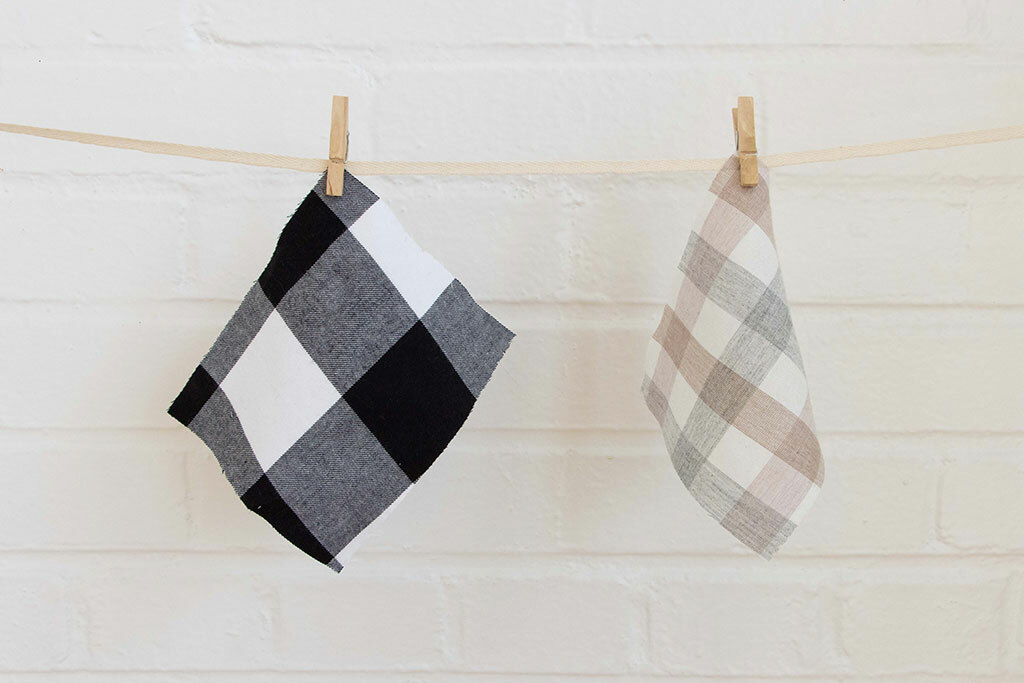
Both of these swatches are 100% cotton flannel. The buffalo check flannel on the left is 151 GSM and is described as having a flexible drape. In contrast, the Italian flannel on the right is 105 GSM and described as “spectacularly” soft in hand with a light, fluttering drape. They are both similar in weight but have significantly different drapes.
How does drape affect the fit of a garment?
The concept of drape is a little more elusive than weight because it is not listed in ounces or grams. So instead, look at how the drape is described—what adjectives does the shop use to describe the fabric?
If a fabric has a “good” drape, it will be more fluid, falling gracefully and clinging easily to the body, perfect for flowing garments like skirts, dresses, and flowy blouses.
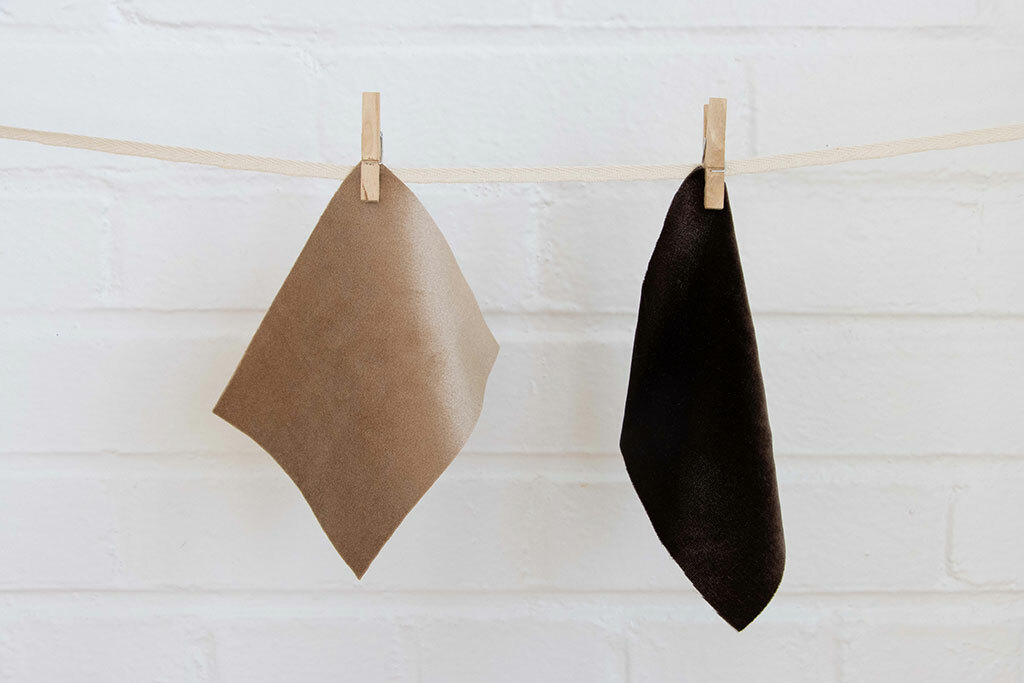
For example, the swatch on the left is a polyester velvet that is 420 GSM. It’s described as having a “moderate” drape, which will work well for pants, more structured dresses (like pinafores), and lightweight jackets.
The swatch on the right is a velvet made from rayon and silk with 150 GSM. It's described as having a very “good” drape. This fabric will work well for more flowy dresses, loose-fitting pants, or tops.
If a fabric is described as having “body,” it is stiff and has less drape. You can sculpt it around your body with seams and darts, ideal for structured garments like jackets or pants.
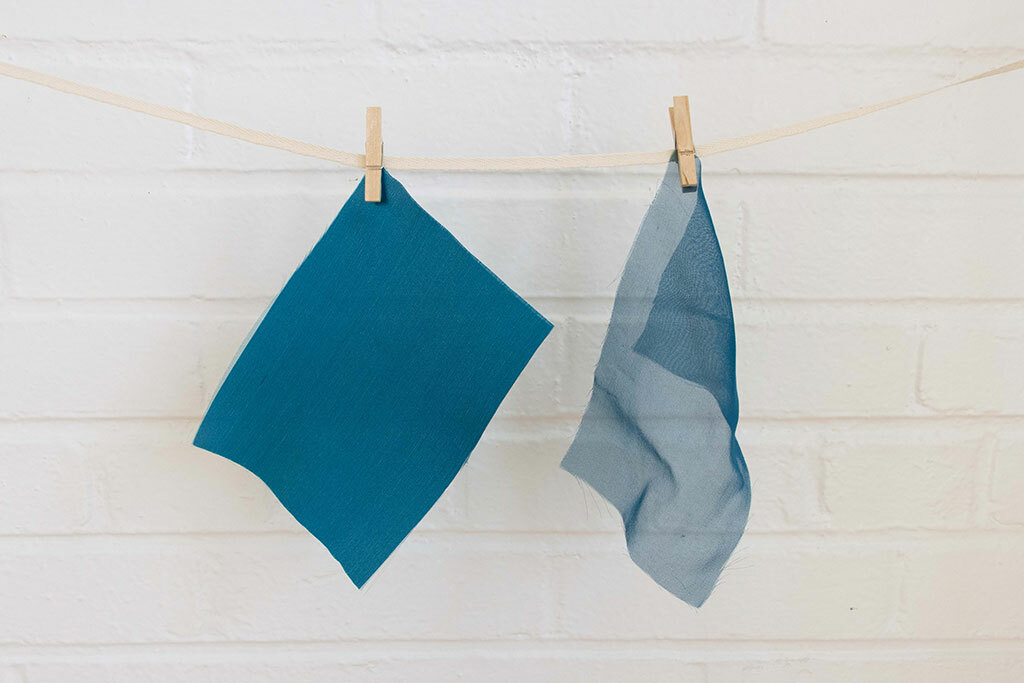
For example, these are both 100% silk swatches. The organza on the left has more body—or less drape—than the chiffon on the right. The organza is 69 GSM and is described as having a crisp drape for voluminous silhouettes. The chiffon is 34 GSM and is described as lightweight and ethereal.
How to shop for the right drape:
Before shopping, describe the drape you want for your project—you can even write down a few words. Pick words like fluid, flowy, or clingy if you want a good drape. For less drape, describe it as stiff, voluminous, crisp, and note that it should have body. For something between the two, write down moderate drape.
As you look at fabrics, ask yourself:
- Will the fabric have enough drape to flow the way I want?
- Will the fabric have enough stiffness to have the structure and crispness I want?
One more tip—you can use interfacing to give fabric a more structured drape (to add body), but you can’t really make a fabric’s drape less structured.
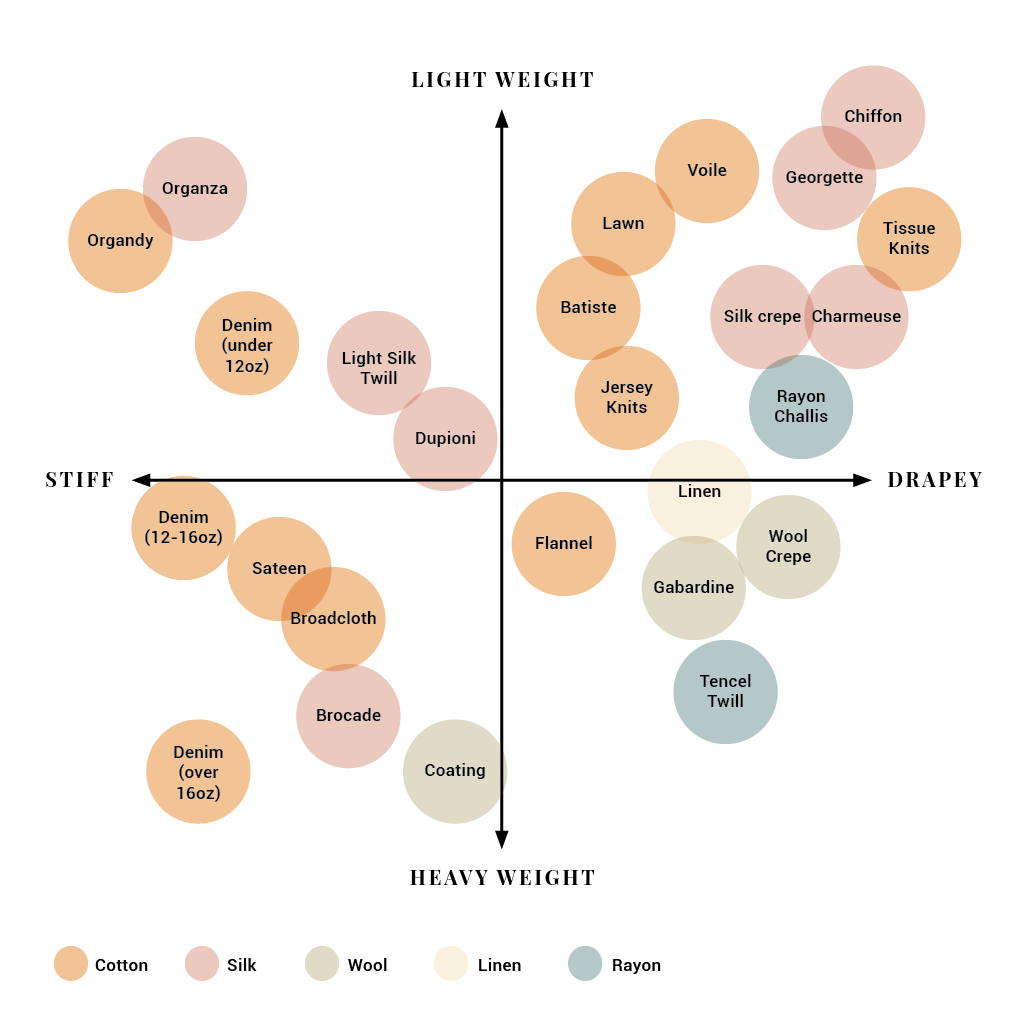
This chart shows different fabrics placed by their weight and drape, so you can see how weight and drape interact. For example, organza is light and sheer, but it’s also quite stiff, whereas a light fabric like chiffon has a great deal of drape. Denim runs the range in weight, but it’s not usually very drapey unless it has added rayon. Heavy, fluid fabrics include wool crepes and Tencel.
Note that this chart reflects averages. Not every fabric will fall in the same place on this chart all of the time, but it's a good starting point.
Example: Knit Swatches
These knit swatches illustrate how weight and drape interact.
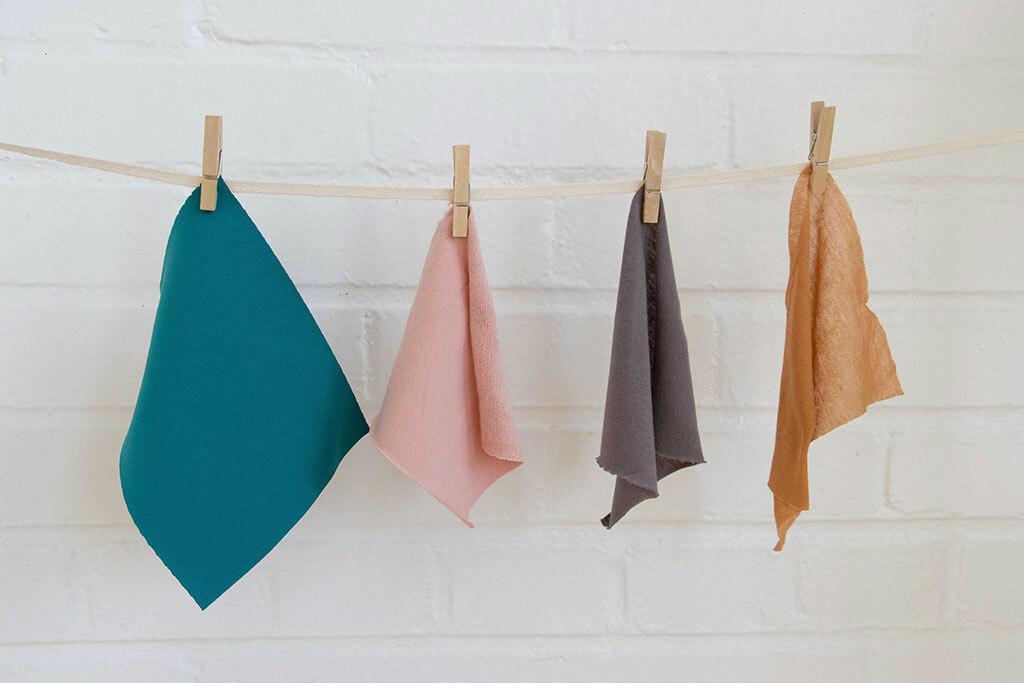
The double knit on the left is a 95% polyester, 5% spandex blend that’s 620 GSM. It’s described as heavyweight with a soft hand and flexible drape. Notice how it doesn’t have folds as it hangs, but it does curve a bit.
The pink French terry is a 66% bamboo, 28% cotton, and 6% spandex blend that’s 270 GSM. It’s described as medium weight, relaxed, and having an extremely soft hand. Notice how it has body and doesn’t fold in on itself.
Next is a 100% organic cotton jersey that is 6.96oz. It’s described as lightweight and soft-handed with a malleable drape. Notice how it has folds as it hangs, which is a sign of good drape.
This tissue-weight jersey is 100% cotton with 52 GSM. It’s described as extremely lightweight, sheer, airy, and flexible. Notice how small the folds are when it hangs, which means it is even drapier than the previous jersey.
What if the fabric doesn’t have a good description online?
Ok, you’ve learned how shops will indicate the weight of a fabric and how they might describe the drape of a fabric. If you’re shopping at a fabric store that uses powerful descriptors like “luxuriously fluid drape,” you might get a great painted picture of how the fabric will work for your project. But if you’re shopping at a store that only lists the fabric contents without any helpful adjectives, then what do you do?
You have to look for clues in the pictures of the fabric.
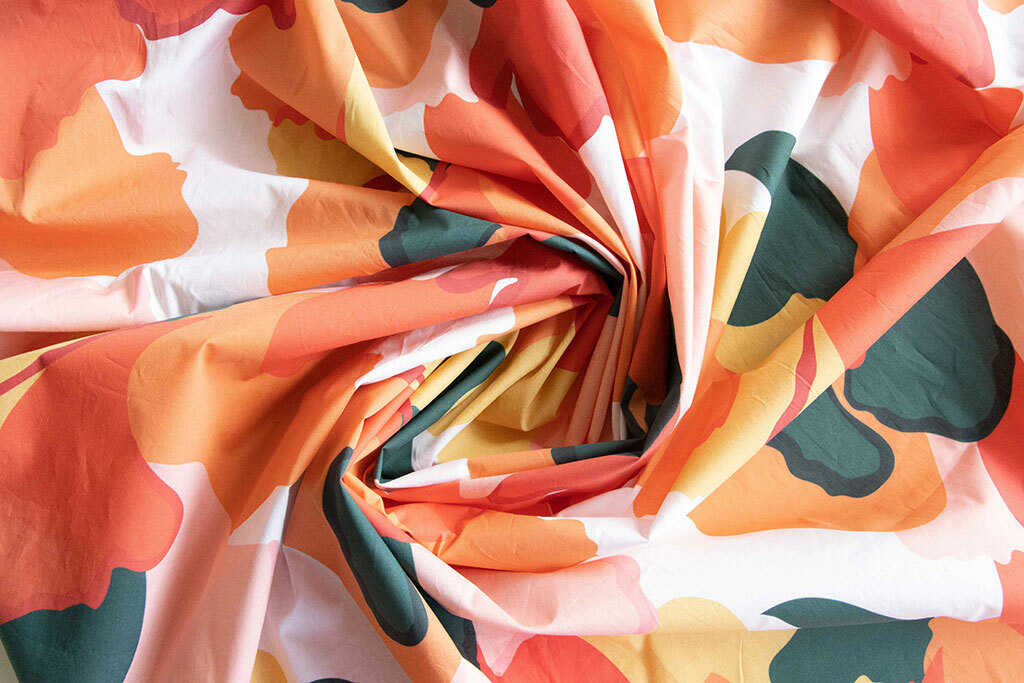
Ideally the shop will show the fabric hanging, crumpled on a flat surface, or at least folded somehow. If you see small folds, the fabric likely has more drape. If you see large folds—or no folds—the fabric likely has more body and less drape.
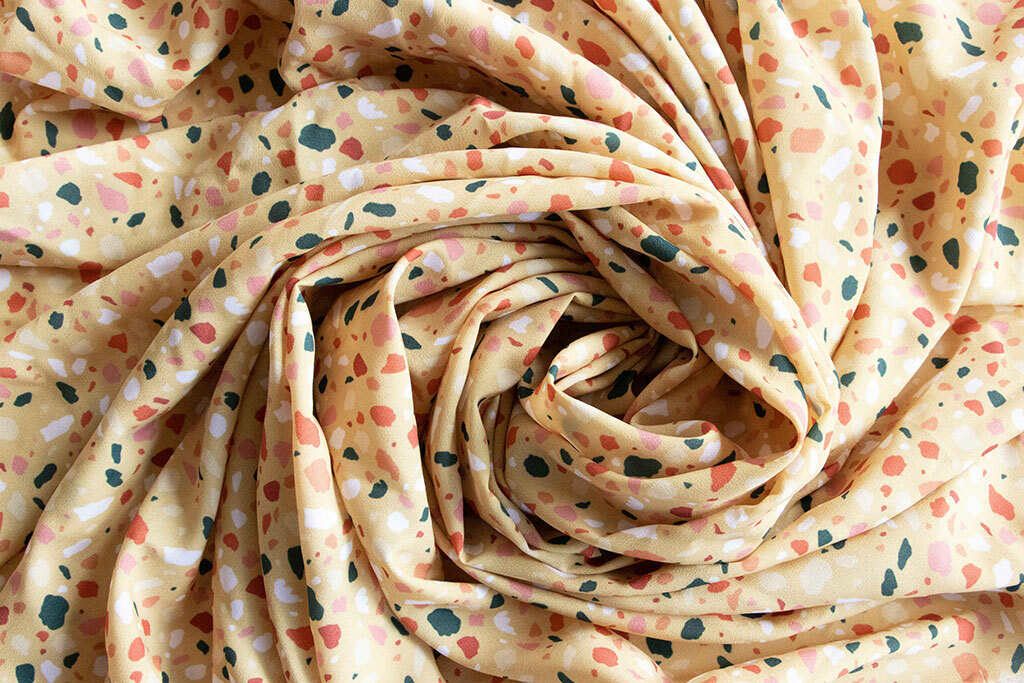
If the folds appear soft, the fabric has more drape, and it will likely skim your body. Conversely, if the folds appear stiff, the fabric has less drape and will likely maintain its structure and sit away from your body.
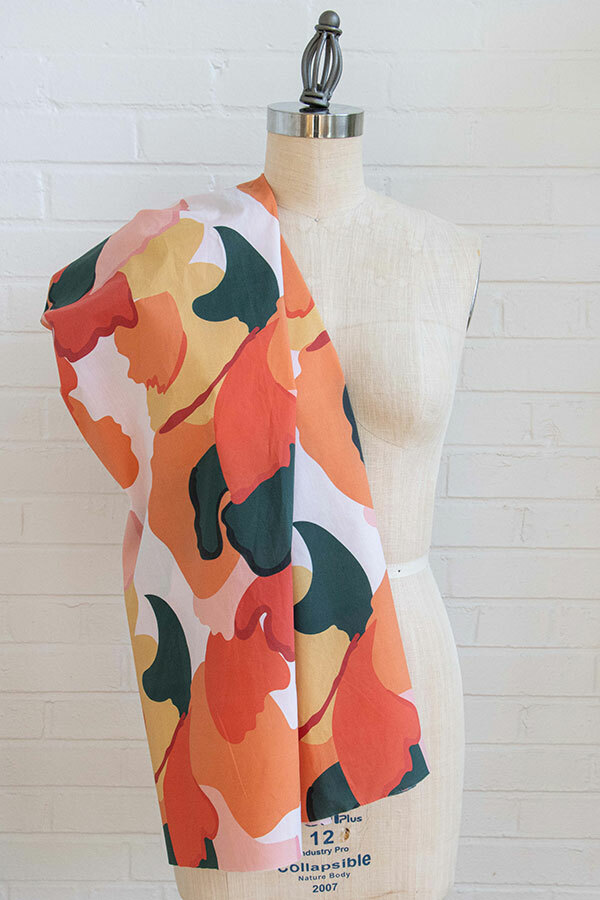
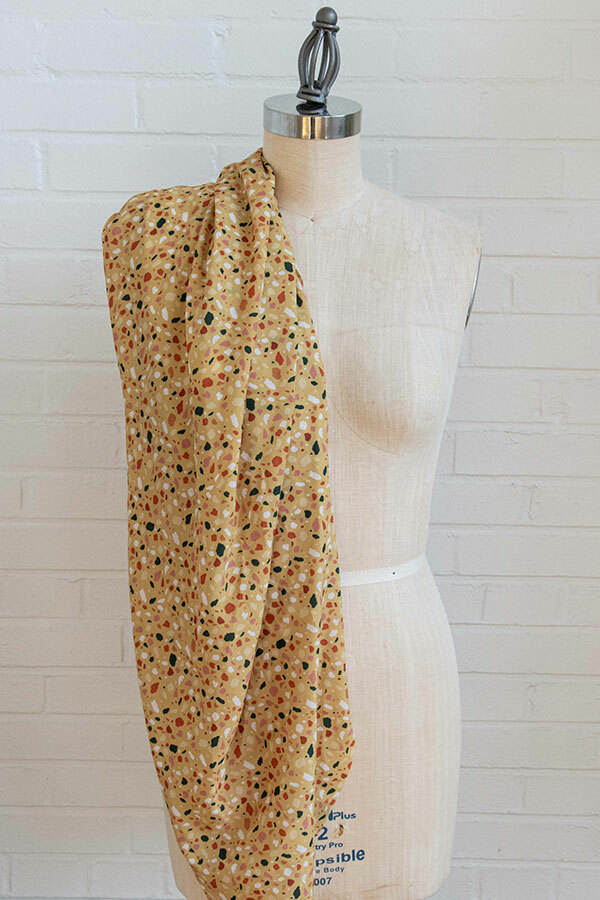
If the weave appears loose or it looks like the fabric is kind of floating on the table, it is likely more lightweight. If the weave appears tight or the fabric is laying more flat on the table, it is likely more heavyweight. But remember that this is when drape and weight can play tricks on you!
The more you swatch, the more you know
It’s hard to learn about all the qualities that go into a fabric--the fiber content, weave, knit, stretch, weight, drape, hand, and sheen. But the good news is that online fabric stores are getting better at providing creative descriptions so you can visualize the fabric without touching it.
To grow your fabric knowledge even more, here are a few quick tips:
-
Get a fabric book. Some of our favorites include Fabric Savvy: How to Choose & Use Fabrics by Sandra Betzina, Fabric for Fashion: The Complete Guide by Amanda Johnston and Clive Hallett, and its accompanying swatch book. -
Start a swatch journal. All of the swatches above were purchased at Mood, a fabric shop with very vivid descriptions. Order a few swatches every time you order some yardage so you can assemble your own swatch book. -
Interview your fabric. Use the questions above to conduct a little interview with a potential fabric. Make sure that the fabric’s online descriptions match the qualities you are looking for.
Love the article? Pin it for later.
